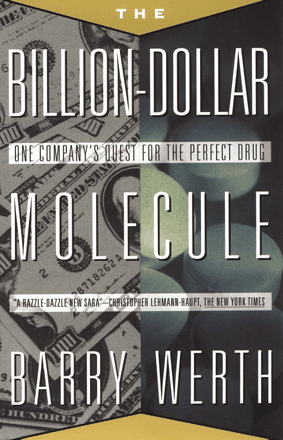Drug Highs, Drug Lows
The Billion-Dollar Molecule. Barry Werth. New York: Simon & Schuster; 1994. 455 pages. $15.00. ISBN: 0671510576

The Billion Dollar Molecule, One Company’s Quest for the Perfect Drug tells the story behind Vertex Pharmaceuticals Inc., following its growth from 1989 to 1994. Vertex, the first pharmaceutical company explicitly created to exploit the concept of rational drug design, was the brainchild of Joshua Boger, a Harvard PhD trained in organic chemistry and Merck’s one-time senior director of basic chemistry, and Kevin Kinsella, a venture capitalist. It began with an illustrious Scientific Advisory Board, including Stuart Schreiber and Jeremy Knowles, as well as the legendary Benno Schmidt as Chairman of the Board of Directors. In contrast to these luminaries, the staff that was first assembled at Vertex was largely young, relatively unknown, and wildly enthusiastic. They would need that enthusiasm as the new company faced setback after setback, as well as the repeated threat of an early demise.
Joshua Boger decided that the company’s first product would be an immunosuppressive agent based on, but better than, cyclosporine and FK-506. This decision was the primary reason he had placed Schreiber on his board. He hired Schreiber’s former colleague Matt Harding, who as a postdoctoral fellow with Robert Handschumacher at Yale, had discovered cyclophilin, the cellular protein that binds to cyclosporine. He also recruited John Thomson, a crackerjack protein chemist from Australia (and now Vice President of Research for Vertex Cambridge), and he hired Manuel Navia, the ace crystallographer and the first of several former colleagues to be lured away from Merck. If Vertex was to succeed against giant pharmaceutical companies like Merck, which had more resources and more money, Boger knew he had to have the best and the brightest. Vertex was not only an experiment in drug design, it was also an experiment in management, whereby staff scientists were assigned a goal and left alone to decide how best to achieve it. This management philosophy was behind Vertex’s amazing early success, although it almost led to the company’s undoing as the company grew.

The book traces the discovery of cyclosporine and FK-506 in soil samples, their use in organ transplantation, the identification of their cellular targets, and the discovery of the pathway involving calcineurin by which they act. From the beginning, this is a story of rivalries: the rivalry between Vertex and Merck; the rivalry between Vertex’s scientists and Stuart Schreiber; and the rivalry between famous transplant surgeon Thomas Starzl and the rest of the world in general.
Given the similarity between Schreiber’s and Boger’s personalities, it seems inevitable that they would come into conflict over the ensuing research into immunophilins, that is, the cellular receptors for immunosuppressive agents. This conflict is a key aspect of the story and appears to arise from Schreiber’s evolution from organic chemist and advisor to Vertex into a powerhouse biochemist, elucidating the signal transduction pathways through which the immunosuppressive agents act. The development of his research along these lines placed Schreiber into direct conflict with the ongoing mission of Vertex, and Vertex always seemed to be one step behind the almost mythical Schreiber. Schreiber, for his part, seems to have forgotten that he was supposed to advance the aims of Vertex, and ultimately, he was removed from the scientific advisory board.
Boger is clearly the central character in the book, as Vertex is really the story of his determination, vision, skill, and chutzpah. During those instances when everything seemed to be going wrong and it looked as if the company were doomed to failure, it was Boger’s sheer force of will that kept it going. Dividing his time between overseeing the science and raising capital around the world, Boger’s portrait at times takes on the qualities of a superhero, although the author is hardly blind to Boger’s faults. For most of the book’s characters, in fact, Werth does a rather amazing job of presenting personalities objectively and even-handedly, describing childhoods, educational backgrounds, role models, and motivational forces with clarity, so that as the story unfolds, you understand the behavior, both admirable and not, of the key players. You will come away from this book with a good sense for both strengths and flaws of the characters, almost feeling as if you had personally met the personalities behind the beginnings of Vertex. This aspect of the book was particularly interesting to me because I had met several of the players, but I certainly never knew them as well as I feel I do now.
This book is extremely well written, and it is easy to forget that the story reflects a factual account of something that actually happened. It reads very much like an adventure novel, rather than a chronicle of the birth and adolescence of a drug company. The chapters that deal with the company’s intial public offering in 1991, given the condition of Wall Street and the venture capital markets at that time, are as tense as many action novels I have read.
The book’s is account of Vertex presents a company undergoing severe growing pains. Founded with the primary goal of using rational drug design to produce a better version of FK-506, the immunosuppressive agent isolated in Japan from soil, the company struggles with whether or not to pursue AIDS/HIV protease inhibitors and other potentially risky endeavors. Ever present in Boger’s mind, as well as that of Navia and the others who were recruited from Merck, is the fact that Merck is working in these areas and has far more money and resources than does Vertex. It is ironic, therefore, that Vertex’s first (and as yet only) drug to market is not a superior immunosuppressive agent, but rather an HIV protease inhibitor—the very type of therapeutic that Boger resisted developing so strongly at the outset.
My one complaint about the book is that it jumps around a bit, both in time and place. But this is a very minor gripe.
Barry Werth is a journalist-at-large whose articles have appeared in The New York Times, Washington Monthly, and GQ . He is a writer worth seeking out to read. Today, still under Boger’s leadership, Vertex comprises 900 employees, with research sites in California, Massachusetts, and the U.K. The company has filed its second drug with the FDA and has fifteen others in development.

- © American Society for Pharmacology and Experimental Theraputics 2003



